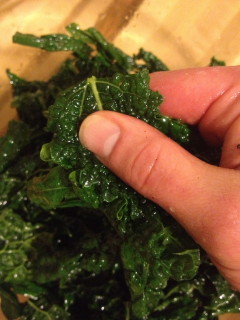Warning: Trying to access array offset on value of type null in /home/devonkarn/rootsnveggies.com/wp-content/themes/herothemetrust/functions.php on line 819
Massaging kale

Alright, why are we kneading leafy greens? That’s crazy talk.
Once you’ve sampled massaged kale, though, it won’t sound that crazy. The basic premise is this: instead of cooking the kale, which leeches its water-soluble nutrients and can lead to a seriously smushy, limp mess, we use acid, salt, and our hands to soften the kale while keeping its texture attractive and its nutrients intact. The result is a tasty side dish or salad base that keeps surprisingly well in the fridge for a few days (unlike other dressed greens).
Here’s how to do it:
1 large bunch of kale, preferably local lacinato or dinosaur kale (the dark, bumpy kind)*
1 Tbsp lemon juice
1 Tbsp olive oil
1/2 tsp kosher salt
* Go for fresh, local kale if you can; it’s available at farmers’ markets and co-ops throughout most of the year (many farmers grow it in high tunnels, so it’s one of the few green veggies you’ll see in the winter). Lacinato kale is best, but green or purple kale is fine, too. A second choice would be a clamshell of baby kale at the grocery store. Avoid the pre-torn, curly, bagged stuff; it’s too tough for this.
 Rinse the kale under cold water and pat dry, or salad spin it. Separate the leafy parts from the tough center ribs; discard the ribs and tear the leaves into salad-sized pieces. In a large bowl, combine the torn kale, lemon juice, olive oil, and salt. Using clean hands, toss everything together to coat the kale, then give it a bunch of good, rubbing squeezes using both hands for about a minute. You’ll notice that the leaves become darker, softer, and a little more transparent – that’s the goal. What you’re doing with the acid of the lemon juice, the grit of the salt, and the friction from your hands is breaking down some of the coarse cell structure of the kale to tenderize it. If you’re not sure whether you’ve massaged it enough, taste a piece; if it’s still super-tough, keep going. If you find that it’s as easy to chew as a romaine lettuce, you’re done. Fresh, smaller, local kale will take less massaging, grocery store-bought kale will take a bit more.
Rinse the kale under cold water and pat dry, or salad spin it. Separate the leafy parts from the tough center ribs; discard the ribs and tear the leaves into salad-sized pieces. In a large bowl, combine the torn kale, lemon juice, olive oil, and salt. Using clean hands, toss everything together to coat the kale, then give it a bunch of good, rubbing squeezes using both hands for about a minute. You’ll notice that the leaves become darker, softer, and a little more transparent – that’s the goal. What you’re doing with the acid of the lemon juice, the grit of the salt, and the friction from your hands is breaking down some of the coarse cell structure of the kale to tenderize it. If you’re not sure whether you’ve massaged it enough, taste a piece; if it’s still super-tough, keep going. If you find that it’s as easy to chew as a romaine lettuce, you’re done. Fresh, smaller, local kale will take less massaging, grocery store-bought kale will take a bit more.
Now just pile it in a bowl and serve as-is or turn it into the base of a salad. That’s it!
Here’s where you can get creative (or simply use what’s on hand) to make the salad a little different each time:
• Vary your acid. Lemon juice is the conventional way to do it, but experiment with other citrus juices (lime, orange, grapefruit) and milder vinegars (white balsamic, cider, raspberry). Even a dash of soy sauce or wine is nice, too.
• Vary your oil. Sesame and other flavored olive oils like truffle, chili, and basil are great.
• Vary your toppings. Massaged kale is best with milder-tasting and texturally varied ingredients so the fresh, green, citrusy notes come through (I find divas like blue cheese and capers to be too much, but you might like it!). I’ve had good results with different combinations of hearts of palm, artichoke hearts, sautéed leeks, grilled chicken, grilled shrimp, shaved fennel, sliced radish, a little red onion, feta, black olives, water chestnuts, baby corn, white mushrooms, sliced almonds, avocado, sunflower seeds, and chick peas. All good members of a choir, really, that aren’t as uplifting as soloists on their own.
So here are three examples of tasty combos:
lime juice + sesame oil + soy sauce + shrimp + baby corn + water chestnuts + almonds
lemon juice + olive oil + feta + chick peas + artichoke hearts + red onion + black olives
white balsamic + hearts of palm + grilled chicken + sautéed leeks + fennel + sunflower
You get the idea. Two bonus points, then I’m done:
• Even people who don’t usually like kale tend to like this salad. My theory is that they’ve probably only had overcooked, limp kale or a super-tough version that makes kale seem better as a garnish or cow feed.
• If you have even a remotely green thumb, kale is really easy to grow and really prolific. Three plants will provide a steady supply of kale for two people from August until the first frost. Lacinato kale is great for this recipe, but most kale varieties will work, too. Growing it yourself makes this dish ridiculously cheap and convenient.
